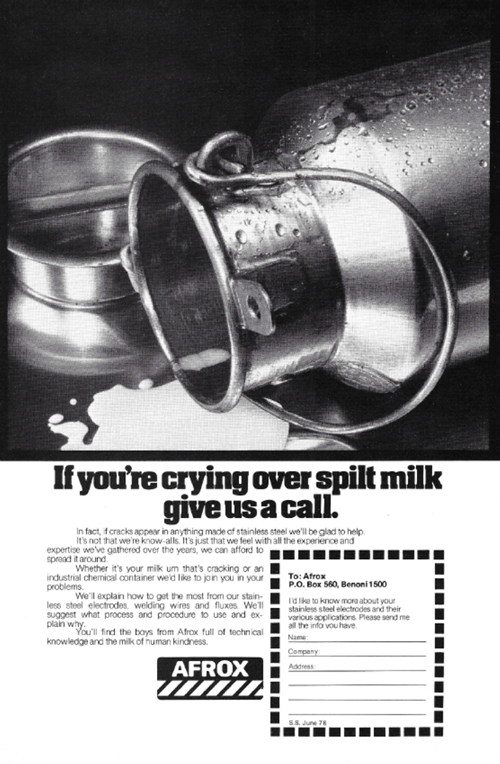- Jacksons appoint Basil Goldswain
- New Combination Handwash Urinal
- Stainless Steel Roofing in Four Mining Applications
- Development Initiative
- Know Your hfa Fabricator ALBERT MOORE (Pty) Ltd
- 2 New Directors for Jacksons Johannesburg
- Nuclear Power Station
- The Automobile and Stainless Steel
- Check! With Stainless Steel
- A Guide to Stainless Steel
- Buyers’ Guide Now Available
- Stainless Steel Label
- Editorial Comment – We Introduce Ourselves
- Editorial Comment
- Gordon Ricketts Retires from S.A.S.S.D.A.
- Stainless Steel Jottings
- Atlas Steels pour metal into first curved slab continuous casting machine
- Cape firm pioneers bulk milk cooling tanks in Stainless Steel
- Company Run Like A Swiss Watch
On 29th May, Escom announced that the R875 million contract for South Africa’s first nuclear power station at Koeberg, North of Cape Town had been awarded to a French consortium. Framatome will supply the nuclear reactors; Alsthom [sic] the turbo-generators and Spie Batignolles (the company concerned in the Saldanha-Sishen and Orange Fish tunnel projects) the civil engineering work. The two unit power station will consist of two pressurised water reactors, each with an electrical output of 922 MW – each almost enough to feed Johannesburg. The first unit is scheduled for commission in November 1982, and the second, one year later.
Iscor’s Newcastle Blast Furnace
The commissioning of the R80 million blast furnace due for the middle of June has now been put back to mid-July because of a shortage of coking coal. Problems arose with labour at mines relying on hand loading, and as Newcastle only has stocking facilities for three weeks, the commissioning was held up. In spite of improved production at the Hlobane and Kilbarchan Mines which supply the furnace, Iscor has arranged contracts for the supply of 1 million tons of coke from overseas over the next two years.
Ship Building
In a short period up to July 1974, Durban ship yards secured orders worth more than R30 million and during 1974 launched a record number of 14 vessels. The re-opening of the Suez Canal has resulted since in a drop in the local ship repair industry of up to 50%, but recent orders from local yards have given the local ship building industry new heart. In February 1975 the S.A. Navy awarded 6 high speed missile carrying vessels to Sandock. In May 1975 Unicorn Lines placed orders for the two biggest ships yet to be built in South Africa (two container ships of 7 000 dw tons each) with Dorbyl. In July 1975, James Brown and Hamer was awarded a R2,1 million Contract for a tug from Iscor. Current orders books show Dorbyl with R30 million and J.B.H. with R20 million. The British Shipping Federation has predicted that the future growth of ship building will be spread to many centres rather than concentrated to the existing specialist countries. A new scheme in South Africa projects a breakers yard (costing R14 million) and a dry dock and ship repair facility in Algoa Bay (costing a further R80 million).
World Demand for coal to Double by 2000
Sir Derek Ezra, Chairman of the British National Coal Board stated that world demand for coal would double by the turn of the century. Coal reserves were vast but difficult to extract and costly to distribute. New techniques such as fluidized bed combustion would advance the traditional bulk energy usage of coal, and the Industry had to move from mechanisation to automation if the price was to be contained.
Houses in S.W.A.
Rio Rinto has recently awarded a contract for 42 three bedroomed houses at Swakopmund, S.W.A. to L.T.A. Construction.
World Beginning a Long Boom
The Economist of London has stated in a May issue that in the first quarter of 1976 “Each of the worlds six largest industrial economies – the United States, Japan, West Germany, France, Britain and Italy – achieved higher industrial output”; “Everywhere idle plant capacity is being brought back into use” … “this should be the start of a long and strong boom” [sic].
What the Rand is Worth
Doctor Frans Pick, the American Financial writer, in a recent survey of the worlds [sic] money, has recently stated that between 1950 and 1974, the purchasing power of the Rand dropped 63% (i.e. it is now worth 37 cents compared to 1950). At the same time, the cost of living has increased by 173%.
Increasing Mine Labour Costs
The Department of Mines report tabled in Parliament at the end of May showed that in the Gold Mines [sic}, salaries and wages had risen three fold [sic] in the ten years 1966 to 1975 to total R600 million despite a 13% decline in the number of Gold Mine [sic] workers. Average earnings (all races) in 1966 were R513 a year and in 1975 R1 670 [sic].
Industrial Silos made of Fabric
Hoechst of Germany have recently launched fibre made up into Silos within a metal frame and state their belief that these high-tenacity fabric bags will take over from Silos made of rigid metal [sic].
The Rossing Uranium Mine
Rio Tinto Zinc announced during May that its mine near Swakopmund, S.W.A., had a total capital cost of R190 million and a rated production capacity of 5 000 tons of Uranium [sic] oxide a year. Daily treatment of ore and waste will rise from 60 000 tons a day to 120 000 tons. The first of 600 houses for African Labour will be ready by September 1976.


